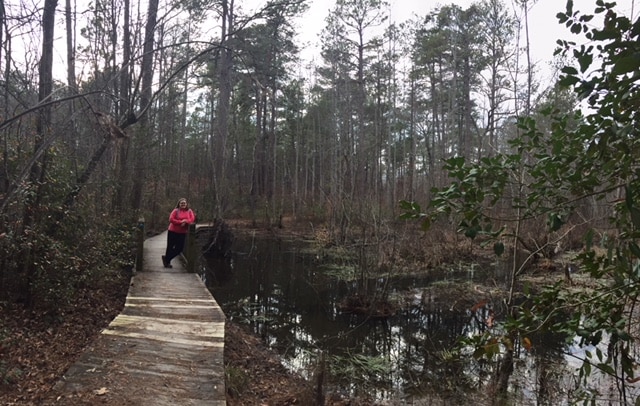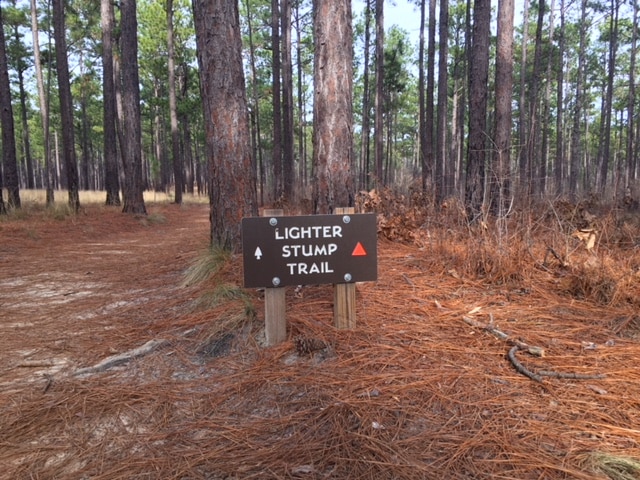
A few weeks back, I had an opportunity to meet with a friend down in the Sandhills and have lunch and go for a walk at a great place – Weymouth Woods Sandhills Nature Preserve. It is located at 1024 Fort Bragg Road, Southern Pines NC 28387. Although the park started with just 403 acres in 1963, it is now a 930-acre nature preserve, and is largely comprised of gorgeous longleaf forest habitat. Some of the trees here are hundreds of years old, and they have been using prescribed fire to enhance the habitat for a number of years.
 Weymouth Woods is also home to the oldest known living longleaf pine, which dates all the way back to 1548. The history of the park is also found on their website. It describes how longleaf were once used to produce turpentine, rosin, pitch and tar, but with the arrival of the railroad, by the 1900s most of the pine trees in the area had been cut down.
Weymouth Woods is also home to the oldest known living longleaf pine, which dates all the way back to 1548. The history of the park is also found on their website. It describes how longleaf were once used to produce turpentine, rosin, pitch and tar, but with the arrival of the railroad, by the 1900s most of the pine trees in the area had been cut down.
In the early 20th century, the grandfather of James Boyd, a well-known North Carolina author, purchased a tract east of Southern Pines to save the longleaf trees from logging. This first property that became a part of Weymouth Woods was purchased and named “Weymouth” because the trees reminded the owner of ones he had seen in Weymouth, England. In April 1963, his widow, Katherine, donated 403 acres – which established Weymouth Woods as the first natural area in our state.
There are over 4.5 miles of trails that can be found here, with some for hiking and some for both hiking and equestrian usage. My friend and I hiked the Bowers Bog Trail to the Lighter Stump Trail, to the Pine Island Trail, then on to the Holly Road Trail. From there we hiked a short connector trail called Moccasin Creek onto the Gum Swamp Trail. Lastly, we turned right onto the Pine Barrens Trail which brought us back to the parking area and park office. We went through a variety of habitats, from longleaf pine uplands with carpets of wiregrass, to hardwood lowlands with boardwalks through swampy areas.

The website for the nature preserve states, “with limited understory, the forest is a natural theatre for birding and wildlife viewing.” My friend who was with me is a great birder, and she helped me identify a number of great species while we were walking. We probably walked for an hour or so, and here are all the species we saw: golden-crowned kinglet, brown creeper, tufted titmouse, Carolina wren, American robin, Carolina chickadee, red-headed woodpecker, ruby-crowned kinglet, pileated woodpecker, red-cockaded woodpecker, and eastern towhee. According to the Weymouth Woods website, over 160 species of bird inhabit the area.
 The Sandhills and Weymouth in particular are home to a variety of unique species, and their website boasts that more than 500 unique species can be found on site. On Sunday, February 24th, the staff is hosting a 1.5 mile guided hike on the Paint Hill tract to find a rare plant, the Sandhills Pyxie-moss. This species exists in only a handful of counties in the Carolinas. This species is one of the first spring plants to bloom at Weymouth. They are meeting at the visitor center and caravanning to the other site, a mile and a half down the road. This event starts at 3:00pm.
The Sandhills and Weymouth in particular are home to a variety of unique species, and their website boasts that more than 500 unique species can be found on site. On Sunday, February 24th, the staff is hosting a 1.5 mile guided hike on the Paint Hill tract to find a rare plant, the Sandhills Pyxie-moss. This species exists in only a handful of counties in the Carolinas. This species is one of the first spring plants to bloom at Weymouth. They are meeting at the visitor center and caravanning to the other site, a mile and a half down the road. This event starts at 3:00pm.